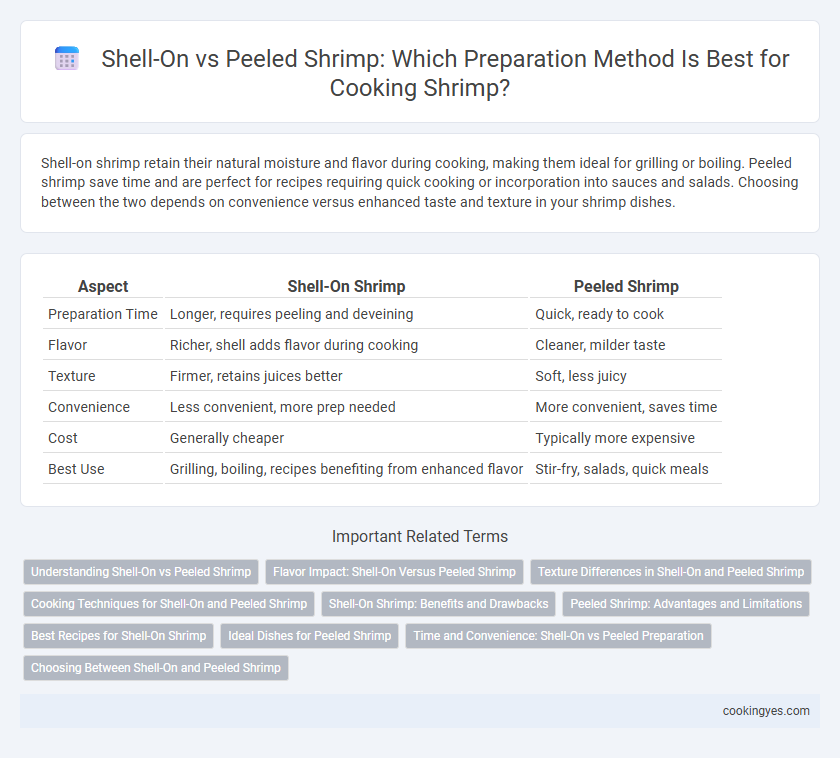Shell-on shrimp retain their natural moisture and flavor during cooking, making them ideal for grilling or boiling. Peeled shrimp save time and are perfect for recipes requiring quick cooking or incorporation into sauces and salads. Choosing between the two depends on convenience versus enhanced taste and texture in your shrimp dishes.
Table of Comparison
| Aspect | Shell-On Shrimp | Peeled Shrimp |
|---|---|---|
| Preparation Time | Longer, requires peeling and deveining | Quick, ready to cook |
| Flavor | Richer, shell adds flavor during cooking | Cleaner, milder taste |
| Texture | Firmer, retains juices better | Soft, less juicy |
| Convenience | Less convenient, more prep needed | More convenient, saves time |
| Cost | Generally cheaper | Typically more expensive |
| Best Use | Grilling, boiling, recipes benefiting from enhanced flavor | Stir-fry, salads, quick meals |
Understanding Shell-On vs Peeled Shrimp
Shell-on shrimp retains its natural protective layer, preserving moisture and enhancing flavor during cooking, making it ideal for grilling or boiling. Peeled shrimp offers convenience and faster cooking times, suited for recipes requiring quick sauteing or incorporation into dishes like salads and pastas. Choosing between shell-on and peeled shrimp depends on desired texture, cooking method, and ease of preparation.
Flavor Impact: Shell-On Versus Peeled Shrimp
Shell-on shrimp retain more of their natural juices and impart a richer, brinier flavor during cooking due to the protective shell trapping flavorful steam and aromatics. Peeled shrimp, while more convenient and quicker to prepare, tend to lose some depth of taste since the shell acts as a barrier that enhances overall flavor intensity. Cooking methods like grilling or boiling amplify these differences, with shell-on shrimp delivering a more robust seafood experience compared to the milder, cleaner profile of peeled shrimp.
Texture Differences in Shell-On and Peeled Shrimp
Shell-on shrimp offer a firmer and more succulent texture due to the protective layer preserving moisture during cooking. Peeled shrimp tend to have a softer, more tender bite, as the absence of the shell allows for quicker heat penetration. Texture preference depends on the cooking method, with shell-on shrimp providing a more robust mouthfeel in grilling or frying, while peeled shrimp excel in delicate preparations like sauteing or salads.
Cooking Techniques for Shell-On and Peeled Shrimp
Cooking shell-on shrimp preserves moisture and infuses dishes with enhanced flavor due to the natural juices locked beneath the shell during grilling, steaming, or boiling. Peeled shrimp offer quicker cooking times and are ideal for sauteing, frying, or incorporating into soups and salads, providing convenience without compromising texture. Selecting the appropriate method depends on desired flavor intensity and preparation speed, with shell-on shrimp favoring depth and peeled shrimp enhancing ease and versatility.
Shell-On Shrimp: Benefits and Drawbacks
Shell-on shrimp retain their natural juices and flavor during cooking, resulting in a more succulent and aromatic dish. The shell acts as a protective layer, reducing overcooking and helping to preserve texture and moisture. However, peeling shell-on shrimp requires additional preparation time and effort, which may be less convenient for quick meals or recipes demanding peeled shrimp.
Peeled Shrimp: Advantages and Limitations
Peeled shrimp offer convenience and faster cooking times, making them ideal for recipes requiring quick preparation or incorporation into dishes like salads and stir-fries. They provide easier seasoning and marinating since the shell is removed, enhancing flavor absorption. However, peeled shrimp can lose some moisture and flavor during processing and tend to be more delicate, requiring careful handling to avoid overcooking.
Best Recipes for Shell-On Shrimp
Shell-on shrimp retain their natural juices and flavor, making them ideal for recipes like garlic butter shrimp or grilled shrimp skewers where the shell adds texture and enhances taste. Cooking with the shell on also protects the shrimp from drying out, resulting in a juicier, more succulent bite. Popular dishes such as shrimp boils, Cajun shrimp, and Asian stir-fries benefit from the added aroma and richness provided by the shells during cooking.
Ideal Dishes for Peeled Shrimp
Peeled shrimp are ideal for dishes that require quick cooking and easy consumption, such as shrimp scampi, stir-fries, and salads, where texture and flavor absorption are crucial. Removing the shell enhances marinade penetration and allows for even heat distribution, resulting in tender, flavorful shrimp. This preparation is also preferred for recipes like shrimp pasta and ceviche, where the shell could hinder the overall dining experience.
Time and Convenience: Shell-On vs Peeled Preparation
Shell-on shrimp requires extra time for peeling and cleaning before cooking, which may slow down meal preparation. Peeled shrimp offers greater convenience with minimal prep, allowing for faster, ready-to-cook usage. Choosing peeled shrimp streamlines cooking processes, saving valuable time in busy kitchens.
Choosing Between Shell-On and Peeled Shrimp
Choosing between shell-on and peeled shrimp depends on the cooking method and desired flavor. Shell-on shrimp retain their natural juices and provide a richer taste, making them ideal for grilling or boiling, while peeled shrimp offer convenience and faster cooking, perfect for sautes and stir-fries. Consider the recipe's complexity and time constraints to select the option that enhances texture and taste without sacrificing ease of preparation.
Shell-On vs Peeled for shrimp preparation Infographic

 cookingyes.com
cookingyes.com